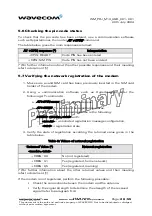
WM_PRJ_M13_UGD_001 - 001
20th July 2004
© 2004
All rights reserved
Wavecom Confidential & Proprietary Information
Page:
42
/
55
This document is the sole and exclusive property of WAVECOM. Not to be distributed or divulged
without prior written agreement.
7.7 Audio
Audio interface is a standard one for connecting a phone handset.
Echo cancellation and noise reduction features are also available to improve the
audio quality in case of hands-free application.
7.7.1 Microphone inputs
The microphone inputs are differential ones in order to reject common mode
noise and TDMA noise.
They already include the convenient biasing for an electret microphone (0.5 mA
and 2 Volts) and are ESD protected.
This electret microphone can be directly connected to these inputs allowing an
easy connection to a handset.
The impedance of the microphone has to be around 2 k
Ω
.
AC coupling is already embedded in the modem.
The gain of the microphone inputs is internally adjusted and can be tuned from
30 dB to 51 dB using an
AT +VGT command (refer to AT commands
documentation [1]).
Pin description
Signal
Sub D 15-pin
Pin #
I/O
I/O type
Description
CMIC2P
4
I
Analog
Microphone positive input
CMIC2N 5
I
Analog
Microphone
negative
input
7.7.2 Speaker outputs
This connection is differential to reject common mode noise and TDMA noise
.
Speaker outputs are connected to internal push-pull amplifiers and can be
loaded down to 150 Ohms and up to 1 nF (see details in table
Speaker gain vs
Max output voltage). These outputs can be directly connected to a speaker.
The output power can be adjusted by step of 2 dB. The gain of the speaker
outputs is internally adjusted and can be tuned using an
AT +VGR command
(refer to AT commands documentation [1]).
Pin description
Signal
Sub D 15-pin
Pin #
I/O
I/O type
Description
CSPK2P
10
O
Analog
Speaker positive output
CSPK2N
15
O
Analog
Speaker negative output













































